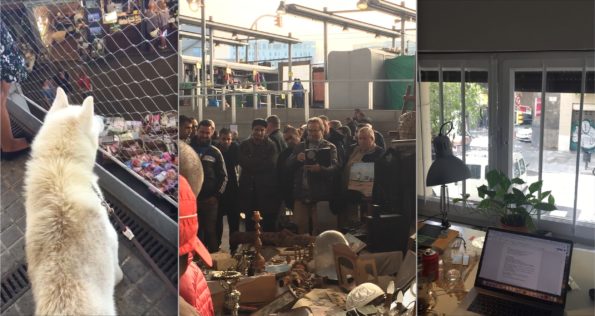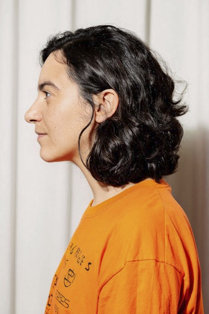Search
To search for an exact match, type the word or phrase you want in quotation marks.
A*DESK has been offering since 2002 contents about criticism and contemporary art. A*DESK has become consolidated thanks to all those who have believed in the project, all those who have followed us, debating, participating and collaborating. Many people have collaborated with A*DESK, and continue to do so. Their efforts, knowledge and belief in the project are what make it grow internationally. At A*DESK we have also generated work for over one hundred professionals in culture, from small collaborations with reviews and classes, to more prolonged and intense collaborations.
At A*DESK we believe in the need for free and universal access to culture and knowledge. We want to carry on being independent, remaining open to more ideas and opinions. If you believe in A*DESK, we need your backing to be able to continue. You can now participate in the project by supporting it. You can choose how much you want to contribute to the project.
You can decide how much you want to bring to the project.

From a seated position I can usually see everything. The only movements that take place in the room are those of my fingers pressing the keyboard, and those of my eyes looking up towards the window and down towards the screen. My neck gets stiff, creating a rigid wave that runs down my back. By day, I don’t switch the light on so that it’s impossible to follow my gaze from outside and only the street is reflected; by night, I switch on a small lamp on my desk, as imperceptible as possible, but even being minimal, it turns my room into the centre of gazes, a spotlight seen from the street. The walls act as drop scenes and the blinds, half drawn, as a hesitant curtain between the beginning and the end of the performance. By night, I switch the light on to edit the notes of all the movements that have taken place outside during the day.
While I remain seated on my chair, everything, absolutely everything is noted down. A stiff neck, dancing fingers, bouncing eyes.
The show starts as 7.30 a.m. Three men are arguing under the window and when they finish, they jump into their vans and head off to the flea market. I lose sight of them.
At 8.00 a.m., not too far from my window, I know they’re all gathered by their stalls. Their lorries having arrived a few hours earlier, they have placed the various objects of the different lots in clever, carefully laid out street displays. Boxes covered in doilies, on top of which stand the items on show. Good books in front, poor books at the back. Large pieces of furniture at the end, like the stall’s retaining wall. Clothes in boxes or trestles, if the garments are of good quality. Jewellery in smaller boxes on top of the larger boxes covered by cloths. The auction starts and a man with an earpiece and a computer sings out the prices. The spectacle begins, in chants. The others gather around the lot, looking at it nervously, figuring out how much the profit could be, then getting annoyed, exchanging glances and increasing the price.
This morning a lorry arrived loaded with the bric-à-brac of a man they imagine is a bachelor; a man they imagine has separated and left the country; a man they imagine has left it all behind to begin a new life. Chanel glasses, fashion labels, large and small motocross boots. Up and up, and the end price soars to € 3600 for the bachelor’s lot.
This is how gestures and time unfold: the man with the earpiece makes an announcement, a wall of people gather around the lot, some of them with their arms on their colleagues’ shoulders, others with their hands in their pockets. They exchange glances; the stakes go up. When the bidding is over, the man with the earpiece prints out a scrap of paper and another man with a smaller earpiece appears behind him and they exchange € 50, € 100 and € 500 notes, in cash, on the corner. The wall of people is prepared to follow the man wearing the earpiece, who has already made his way to another lot. The buyer stays back, behind the group and behind the little boxes, the books and junk, watching over his new purchase.
It’s now 9.00 a.m. By nine o’clock all is clear — the prices of each lot, and who has to bid behind each stall. And collectors take the stall by storm; they compete, put on their glasses, sneer, contradict those who have bought the lots, haggle and shortly afterwards leave.
At 9.30 a.m. the vans are back in my field of vision, at the corner, and two neighbours bring out their three dogs – a Yorkshire Terrier and two that resemble Ewoks, with bright eyes and no cataracts of sadness – and my heart sinks into melancholy and emotion. Time passes for everybody, human beings and animals alike, everyone tells me, as if human beings had ever ceased to be ‘beasts’.
At 10.00 a.m. the four businesses that still exist on the street open and I sit up in my chair in order to type better. My theatre has begun. All the light is outside.
The shoe salesmen start to dance before welcoming their customers. They open up their premises, bring out their ladders – the men climb the ladders while the women support them – they hang up their posters and adverts and bring out their trestles with more shoes. Further down the street, three drivers sit on chairs to watch videos on their mobile phones. Several scenes are taking place on the same stage, as in The Little Shepherdsplay. But the peaceful genre scene of the street and its rhythm are interrupted by a new sound, a sliding movement scarcely heard in the neighbourhood: a group of young boys dragging trolleys along and bringing them to a halt in the entrance to my building. They ring the bell, cry out and enter.
When I began my research and observation of the gleaning process,[1]I thought it was a radical way of eradicating extraction, serial production. That it would work like recycling, ceasing to produce, using what has been mass produced, challenging its residues and proclaiming ‘No to labour, no to production’ and ‘Yes to monetary or non-monetary exchange, always arbitrary and exploitative’. But everything collapsed when I saw that in the choreography of gleaning we find classes and privileges, and that it’s structure isn’t as democratic and friendly as it would seem to be from what is imaginable, from Agnes Varda’s documentary,[2]from the distance of my observation chair. The processes of gleaning and extraction have invisible choreographies in inaccessible chains that I would now like to trace.
The neighbourhood gleaning begins with evicted homes, the homes of the deceased, of elderly women, of elderly men sent to old people’s homes, of separated couples who leave lofts full of bric-à-brac for a new life, of those vulnerable of being displaced. The extraction of the trolleys, the use of these emptied spaces for economic profit via tourism, fills them starting from invisible chains, extraction chains that create other choreographies with other scenes, other movements that are less The Little Shepherdsand a great deal Samsonite + Airbnb. Both gleaners and extractors appear as masters to bring the object back, not as a fetish but in order to keep it alive in a sort of non-productive consumption economy. And now I find myself doing the same thing, sitting in front of my chair, typing and keeping the scenes of both alive in my field of vision.
In recent years, writing and the impossible conquest of language have made me try to blur the line between speaking and writing and start to write in a speechifiedway. Compiling phrases and oral conversations to transcribe them and transform them into written text; writing a text to be spoken, and learn it by heart to recite it as if it had always remained on the level of orality. For me, everything collapses into text-languages.
The texts have been the object of three searches: the physical text, for finding verbs and words present in objects and installations; the speechifiedtext, where it appears as a structure that is induced by its pronunciation; and the choreographic text, the possibility of writing without moving and of moving when writing.
It is from this position, seated on the chair, eyes attentive and fingers at the ready, that I pick up the choreography I see through the window like master gleaners and, maintaining the gesture and tracing the movement from my stillness, I extract everything from it, re-examining trajectories and twisting and turning streets from my galactic armchair. The phrases are transcribed, the movements are noted, and I choose what was seemingly useless. Am I operating like the extraction trolleys and the shepherd-gleaners? The scenes have now become texts, the movements and phrases have become writings. These will then be spoken, recited and read, but no invisible, extractive, slush-fund chain is taking place. Scenes and discourses have simply been displaced, changing place when they are noted and choreographed on my keyboard.
[1]Gleaning is gathering or collecting in small quantities the heads of corn or other cereals after the harvest. There are also urban gleaners, who collect the objects that people leave out on the streets. A number of laws endorse the gleaning practice, based on texts compiled in the Bible in defence of gleaners, to enable the vulnerable to gather food from the fields.
[2]The Gleaners and I, 2000, Agnès Varda. Original French title, Les glaneurs et la glaneuse.

Claudia Pagès’ work circulates word, body, music and movement in multiple directions, tracing the continuity of systems of circulation -such as navigation and transport- alongside language and legal languages. Pagès focuses on the ‘architectures of containment’, which maintain power through the flow of commodities and capital, paying particular attention to water, paper and language.
Pagès has read, performed and exhibited at various international institutions, among others Manifesta15, Sculpture Center (New York), CA2M, IVAM, MACBA, CAPC Bordeaux, HAU2 or Sharjah Art Foundation. She has been awarded the Mondriaan Werkbijdrage Jong Talent in 2016 and Ojo Crítico Artes Visuales in 2022. She has published Her Hair (Onomatopee, 2020); her first novel Més de dues aigües (Empúries Narrativa), and is preparing a book with Wendy’s Subway.
Portrait: Eva Carasol
"A desk is a dangerous place from which to watch the world" (John Le Carré)